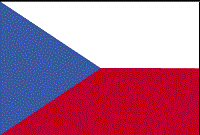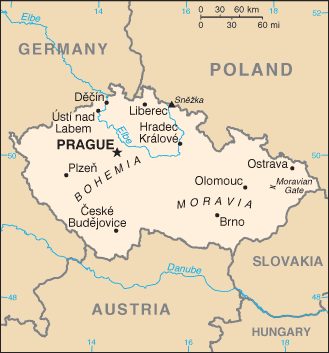Sep 7 2012
Topics Covered
Welcome to Czech Republic
Overview of Resources
Industrial Minerals
Metals
Fossil Fuels
Investment
Sources
Welcome to Czech Republic
Czech Republic, with a total population of 10,177,300 as of July 2012, is located in central Europe, between Germany, Poland, Slovakia, and Austria. The country mostly has a temperate climate and covers a total area of 78,867 km2.
 |
The national flag of Czech Republic.
Image Credit: CIA Factbook. |
Czechoslovakia as a country was formed towards the end of World War I by the merging of the Czechs and Slovaks. The country was later divided in to two national components that included the Czech Republic and Slovakia on January 1 1993. In 1999, the Czech Republic joined NATO and in 2004 the country joined the European Union (EU).
Czech Republic is known for its prosperous and stable market economy. Though the country has a healthy financial system its economic status is also dependent on its export trade.
In 2008, for instance, the demand for Czech goods from Germany and Western Europe dropped due to the 2008 recession. This decrease in demand resulted in a 4.7% drop in the 2009 GDP. However, from the second half of 2009, the country experienced a slow recovery in its GDP that improved in 2011. Czech Republic’s GDP as of July 2011 was $288.6 billion.
Overview of Resources
The key natural resources of the Czech Republic include timber, soft coal, hard coal, graphite, clay and kaolin. The production of coke, steel and coal are of regional and domestic importance in the Czech Republic.
Czech Republic’s dependence on imported natural gas for the production of electricity was maintained at a low level as the country used nuclear power and produced coal for its thermal plants instead of importing natural gas.
Industrial Minerals
In 2010, a Czech Geological Survey highlighted that only a small share of the overall external trade of the Czech Republic was made up by the mineral commodities.
In 2010, the Czech Republic experienced an increase in the production of dolomite, bentonite, pig iron and bentonite. The country also saw a decrease in gypsum, and common gravel and sand production.
Metals
Czech Republic imports iron ore products as the country has no iron ore deposits that are economically exploitable. In 2008, for instance, the country imported about 7.7 Mt of iron ore and concentrates. About 27% of these imports were from Russia and about 60% came from Ukraine.

The map of Czech Republic. Image Credit: CIA Factbook
Fossil Fuels
Imports of mineral fuels were the only mineral commodity trade happening in the country in 2010. In 2009, 8.51 billion m3 of natural gas and 208,800 barrels per day of crude oil was imported by the Czech Republic. In 2010, the country saw a decrease in crude petroleum.
In 2010, the Czech Republic was found to be self-sufficient in the production of coal.
In 2010, Czech Republic’s only domestic producer of uranium was Diamo that supplies one-third of the country’s uranium to CEZa.s., the company that owns two nuclear power plants of the Czech Republic. Uranium produced in the Czech Republic is sent to Russia where it is further processed into fuel.
Investment
Recent mining reports highlight that mayors of the villages and towns of the Czech Republic have decided to challenge the Industry and Trade Ministry’s new raw material policy that intends to carry out three major plans which include:
- Removal of limits to coal mining in north Bohemia.
- Opening a test pit in the Frenstat mine in the Beskydy mountains of north Moravia.
- Resuming mining of uranium in the Podjestedi, north Bohemia.
These plans were criticized by environmentalists, who feel that this concept suppresses the development of renewable energy sources, ignores the importance of saving energy and strengthens the energy industry’s dependence on nuclear power, coal and oil.
Apart from this new energy concept, the country’s Industry and Trade Ministry has also planned to set up a nuclear waste repository whose location will be decided by 2015.
Since 1996, the Diamo, a national uranium company in the Czech Republic, has been working towards cleaning up of toxic waste left behind by years of uranium mining. This clean up process aims at preventing contamination of the country’s fresh water system and the Elbe River. This entire work is expected to extend for 30 years and will cost about $2.75 billion.
The Czech Republic aims at reducing its dependence on Russia for fuel and this will indeed affect the trade balance to a major extent. The production of coal, on the other hand, is likely to be stable and play a major role in the country’s fuel requirements for generating electricity.
With significant focus on coal production and mining of uranium, the Czech Republic is expected to see significant improvement in its economic status and be self-sufficient in the production of fuel in the future.
Disclaimer: The Author of this article does not imply any investment recommendation and some content is speculative in nature. The Author is not affiliated in any way with any companies mentioned and all statistical information is publically available.
Sources